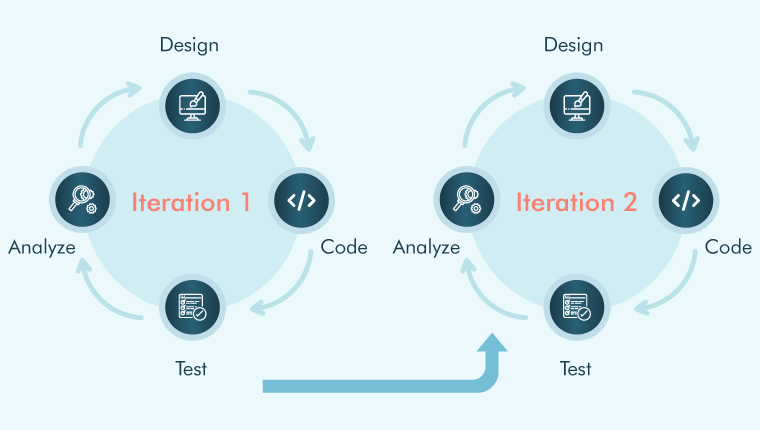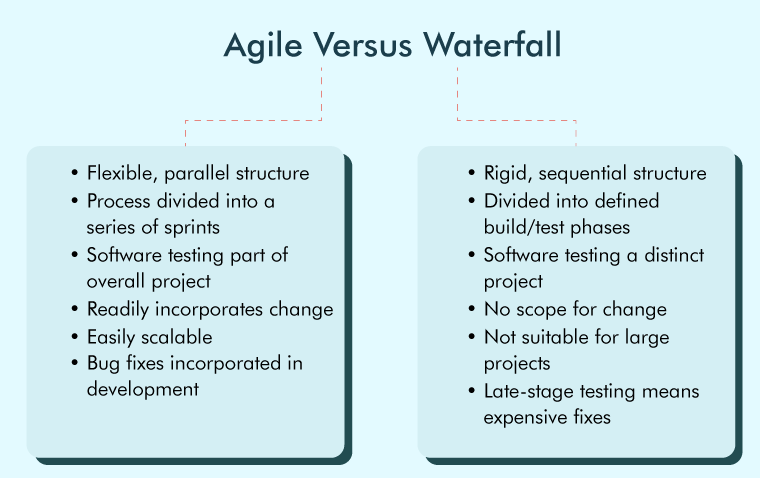
Agile testing is your future. It will save you time. It will save you money. It will save you resources.
The gold standard of QA methodologies, Agile testing and development are designed to evolve with the product. This process is built to match the pace of today’s software development market that demands higher testing speeds and higher quality products that deliver better experiences for customers.
Agile process builds better products faster by harnessing the collaborative talents of your entire enterprise and your QA expert toward incorporating the testing phase within a continuous cycle of design, coding, testing and analysis. It is a harmonious series of iterations that flows toward the release of a final product that is informed by business, development and testing experts.
It saves you time by incorporating change as it occurs.
It saves you money by testing smarter.
It saves you resources by providing ongoing integration between development and testing.
The goal of Agile testing and development is to produce high product quality. It is achieved through collaboration, iteration, and rapid and repeatable delivery.
What Is Agile Testing?
Agile Advice
QA engineers and developers work in parallel under the Agile method, so the importance of your QA team should be emphasized frequently.
Agile testing was developed as a response to the rise of Agile software development. 97% of organizations practice Agile in some form. As with the development version, Agile testing operates on the principle of continuous improvement. In the development world, this improvement means the ability to adapt to rapid changes in markets and technologies. That same thinking applies with Agile testing, but it is more sharply focused on the changes that occur within a product.
In practice, Agile testing supports an evolving cycle of iterations, each improving on the previous until a final high-quality product is delivered. The Agile model flows through iterations of analysis, design, coding, testing, and back to analysis, like this:

Agile Advice
Agile testing depends on a clear line of communication between the product managers, Scrum Masters, engineers, and QA testers that are delivering the product.
The elemental point is that the silos and barriers of legacy testing models—primarily Waterfall methodology—are removed in favor of a collaborative product evolution. No longer do developers work in isolation and then throw their product over to the QA team for testing when it is “finished.”
The expectation of change is built into the Agile model so that the project can develop as a continuous flow rather than a fragmented and sequential process.
Agile vs Waterfall
The advantages of Agile testing become apparent when you compare the methodology to the traditional Waterfall approach. The latter divides development phases into distinct and exclusive functions, almost creating competing interests within your product delivery. A case in point: engineers do not want QA testers finding faults in their work, QA teams must prove their value by detecting bugs. This division also makes it expensive and time consuming to integrate corrections and improvements into the final product.
With the Waterfall methodology, development may take place for three months, and then QA takes place for three months. One process does not pick up until the other has come to a stopping point. But what if the QA team discovers a big bug toward the latter end of this collective process? The strategy is not well suited to flexible troubleshooting, and the resulting delay could have serious repercussions.
With the Agile approach, teams are trading off development and testing, development and testing. They are in a position to find bugs sooner and get software to market much sooner. And under this model, teams are set up for meaningful collaboration, communication and proactive goal-setting.
Even when it means disrupting a legacy software development system already in place, making the change to Agile brings countless benefits for the immediate and the long-range future. The practical implementation of the Agile methodology can produce real-world savings in resources, money and time. The advantages of Agile testing will improve your ROI.

Agile testing is closely associated with two other product development ideas that also embrace a collaborative, continuous cycle method. DevOps and Scrum have evolved from the Agile methodology.
Agile vs DevOps
DevOps is the intersection of development, QA and IT operations. It is an Agile relationship. It describes the way these three teams collaborate to deliver continuous integration, monitoring and delivery. Fluid and constant communication among these experts is the backbone of a flexible and productive environment.
Agile vs Scrum
Scrum is one of the most popular frameworks that has evolved from the Agile process. It works on a series of relatively short sprints that take a product feature through the analysis, design, coding, testing cycle described above. Scrum teams are cross-functional experts that put Agile collaboration into practice.
Agile vs RAD
Like Agile development, rapid application development or RAD aims to deliver software to the user as quickly as possible. It is an engineering methodology that is committed to flexibility and adaptability for software development specifically.
Even more than does Agile methodology, RAD prioritizes early action and prototyping over planning, with the understanding that the best methods and product features will reveal themselves in development cycles. Whereas many Agile best practices are implemented from the very start of the development and testing cycles, RAD tends to be even more flexible in order to develop a prototype as quickly as possible for feedback and change to begin. Like Agile, RAD assumes that change is a given and embraces revisions by actively responding to the client’s or tester’s feedback.
Agile vs Lean
While Agile focuses on the collaborative approach to adaptability and quality of software, Lean development focuses on the efficiency of the process itself. Lean attempts to reduce procedures and steps to a value-driven minimum. Agile and Lean are not necessarily mutually exclusive methodologies. Together, Agile and Lean principles expect uncertainties and adapt to product development and testing cycles.
Lean and Agile both initiate important alternative principles to Waterfall-style project management. Both are cooperative approaches, but Agile tends to promote proactive planning and strategy, whereas Lean tends to promote reactive changes in development, waiting until the last moment in a cycle to minimize the possibility of unnecessary effort and resource expenditure.
Advantages of Agile Testing
Agile testing and development is a collaborative, evolving approach toward producing real-world advantages—better processes for making better products. It maximizes the cross-functional talents of your team and the steady flow of repeated iterations to get you to release faster.
Change Is Part of the Process
Agile testing is built with the unknown in mind. The cyclical process allows for change and improvement to occur logically at every iteration.
No Hidden Costs
The evolving nature of the Agile approach means you’ll know in advance that changes will be made, as opposed to a sequential approach that leaves you crossing your fingers that the QA phase does not uncover any critical errors.
Agile Advice
Your QA engineers should be present during early planning and requirements analysis so that they have a clear idea of the customer's expectations from the start.
Easy Workflows
Tight and easy workflows enable close collaboration among teams as they can maintain a clear understanding of the project and requirements as a whole. Easy workflows also allow for greater flexibility and adaptability to testing and development.
Testing in Parallel
Parallel testing allows for the simultaneous testing of multiple product features, which has obvious time and resources benefits. It is a function of the test framework that thrives under Agile conditions where multiple Scrum teams can execute short sprints as a kind of testing force multiplier.
Project Tracking and Delivery Timelines
Breaking the project down into small sprints allows your team to better deliver against release cycle pressures. Bugs are identified and corrected easily, and improvements are made without grinding development to a halt. Meanwhile, careful documentation allows teams to learn from previous cycles and accelerate development.
Agile Advice
QA engineers are used to experiencing products through the eyes of the user, so their input can be incredibly valuable when it comes to reviewing user stories and deciding which areas need improvement.
Continuous Improvement
Under Agile conditions, testing becomes more than just a search for bugs. Your QA experts’ understanding of your domain and the needs of your users can be incorporated into the cycle to improve your product at every iteration.
Project Reporting
Careful reporting is critical to supporting consistent and proactive collaboration. Agile also involves a commitment to providing feedback and suggestions. The focused interactions among teams then result in ideal product improvements.
Broader Coverage
Agile teams allow for the input of cross-functional talents to ensure the product is delivered against the highest business, technical, coding and user expectations.
One of the most important advantages of the Agile approach is that you can make better use of remote and offshore QA opportunities. Within a collaborative methodology, external QA experts can bring their experience and domain knowledge to bear on the final product. They become teammates rather than consultants.
Agile Methodology's Impact on Software Methodology
-
Quality and Team Involvement
Agile methodology is a widely used approach to software development that seeks to produce high-quality software quickly and effectively.
Based on a set of guiding principles, this emphasizes:
- Adaptability
- Flexibility
- Teamwork
-
Transparency and Strong Action for Major Stakeholders
The agile technique has a good effect on meeting customer expectations through timely software delivery and quick responsiveness to changing requirements.
It encourages the end-user to participate actively in the project's direction and establishes the proper expectations for the customer.
-
Regular Retrospectives and Iterations
The agile methodology encourages holding regular retrospectives to identify and address any problems that develop in projects with a lot of unknowns (designs and functionality).
-
Control Over Budget and Schedule
There are lower levels of misunderstanding and miscommunication and realistic expectations for delivery. Due to the constrained scope of work that is typically established inside a given sprint in an agile setting, it is considerably simpler to give clients realistic cost and scheduling estimates for projects within a given period when using agile development.
Tools for Performing Agile Testing
It is a popular tool used for Agile project management and also has powerful test management features.
It is a comprehensive web-based test case management software that helps you manage, track, and organize your testing efforts.
It is a popular test management tool that integrates with Jira and offers features such as test case management, test execution, and reporting.
This is a comprehensive test management tool that supports Agile and DevOps methodologies.
It is a web-based test management tool that offers features such as test case management, test execution, and reporting.
This tool is an agile test management tool that integrates with Jira and offers features such as test case management, test execution, and reporting.
(Quality Center)
It is a comprehensive test management tool that offers features such as test planning, test execution, and reporting.
It is a comprehensive test management tool that offers features such as test planning, test execution, and reporting.
Remote and Offshore Agile Testing
Our digital world has put us all in a position to speak face-to-face, no matter where geography grounds us. Communication devices such as video conferencing, messaging, email and workplace collaboration apps like Microsoft Teams and Slack make meeting across city, state and national boundaries effortless.
As a direct result, it has never been easier to incorporate the benefits of remote and offshore QA testing into an Agile environment. Your external QA experts can participate in workflows and team meetings as efficiently as if they were seated in the next room. The communication challenges are comparable with those you would face in an internal setting, and you get to maximize the Agile advantages above by adding resource, time and expertise efficiencies beyond your team’s own capacity.
Those benefits of outsourced Agile testing include:
Domain Expertise
Call on industry experts who are familiar with all the latest trends, tools, technologies, and security and regulatory demands of your domain.
Resource Savings
Offshore and nearshore Agile QA services are far less expensive to train, maintain and reuse than domestic sources are. Outsourcing to India can reduce your QA costs by 50%.
Rapid Scaling
Introducing an external QA provider means you can rapidly scale up your output for targeted periods around your release cycle without having to carry a long-term human resource cost.
Agile Advice
Leverage unit testing, continuous integration and acceptance tests to help drive product development forward faster and more effectively.
Build Faster
QA experts know what they are doing. The right QA partner can be trusted to onboard quickly and execute their tasks efficiently. Plus, they can introduce your internal team to documentation, reporting and test production best practices.
Maximize Your Resources
Integrating a QA expert means you can leave your internal team to focus on their core duties. Reduce stress and workload on your creative and developmental minds without having to sacrifice speed and coverage.
Create a 24-Hour Workflow
The time difference between the U.S. and popular QA locations, such as India, allows you to work around the clock. Your QA team can test overnight and prepare reports for your engineers to access in the morning.
Engaging the services of an experienced and talented QA team lets you value-add to your Agile environment. The combined time and resource savings make it well worth your while to consider changing the way you approach QA testing.
Making the Switch to Agile Test Strategies
Making the switch to an Agile environment can seem daunting if you are accustomed to a more sequential methodology. However, with an experienced guide, it is very possible to adapt and quickly benefit from the Agile advantages. It begins with getting everyone in the same room. You have to break down the barriers of your existing culture and create a more collaborative one that gives every team member responsibility over the quality of the final product.
To ease the transition, partner with a QA team of experts in Agile. These consultants will quickly be able to identify areas for adaptation and will become a part of your collaborative testing and development team. We have included below a short list of best practices you can expect that will help your team meet the new challenges and realize the benefits of working with an Agile approach.
Train on Agile Processes and Tools
Provide training to your engineers on Agile practices and terminology, such as Scrum, sprint tasks and story points, to highlight the differences of the approach. Your team should also be exposed to Agile tools used to track progress, including how to handle time and tasks and how to mark sprints as complete.
Agile Advice
Automation helps eliminate needless manual interaction and is a perfect match for the speedy, efficient nature of Agile QA.
Standardize Documentation
You need to create standard templates that your team can use to document processes with precise, detailed information. Consistency is key to collaboration.
Improve Communication
As with the use of standard documents, your team needs to learn efficient means of communication to create momentum. Use every technology available from phone and email to video conferencing and chat messaging.
Prioritize Tasks
Every member of the team should be aware of any specific task’s importance and volume and prioritize it accordingly. Related tasks should be grouped together to aid efficient development.
Share Information and Perspective
Every member of the Agile team should be informed of the overall product development progress. It begins with cross-functional teams attending scoping plans and continues through the build with regular discussions and scheduled meetings.
Agile testing requires us to change the culture of our organizations. What we get in return is a more efficient and rewarding use of the talent and expertise that we have on hand. Collaborative teams build better products. New Agile habits are within reach when you have QA expertise on your side.
Agile Testing Is Your Future
Agile testing is the future of product development. With the right QA expert on board, your team can produce better products faster by working within a continuous, evolving and collaborative environment. It is a logical extension of the development and testing processes where the talents that built the product and the QA experts who know how to realize its potential work together.
QASource has a proven track record of creating and leading Agile teams. Our engineers have 1,000 years of collective software testing experience that lets us reduce training costs and delays and immediately scale your services as needed. With an international presence on three continents and access to the latest tools and technologies, we can become a valued part of your product development team. Contact us today for a free quote, or call +1.925.271.5555 to get started.
